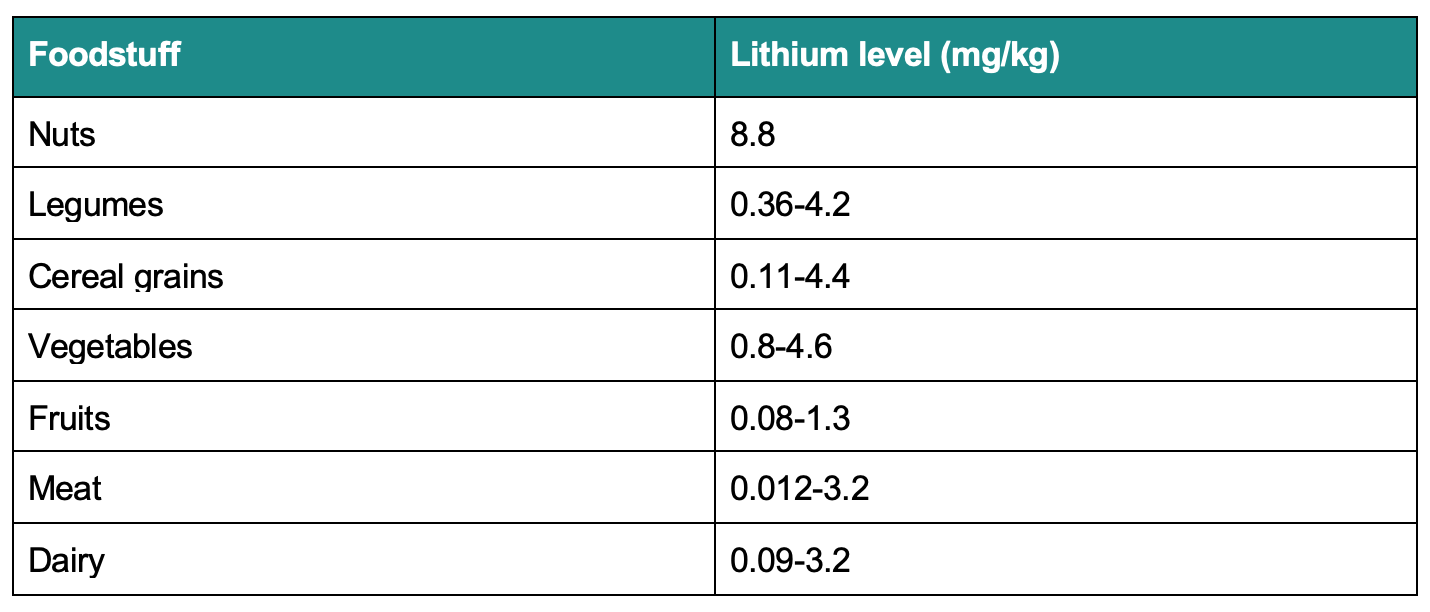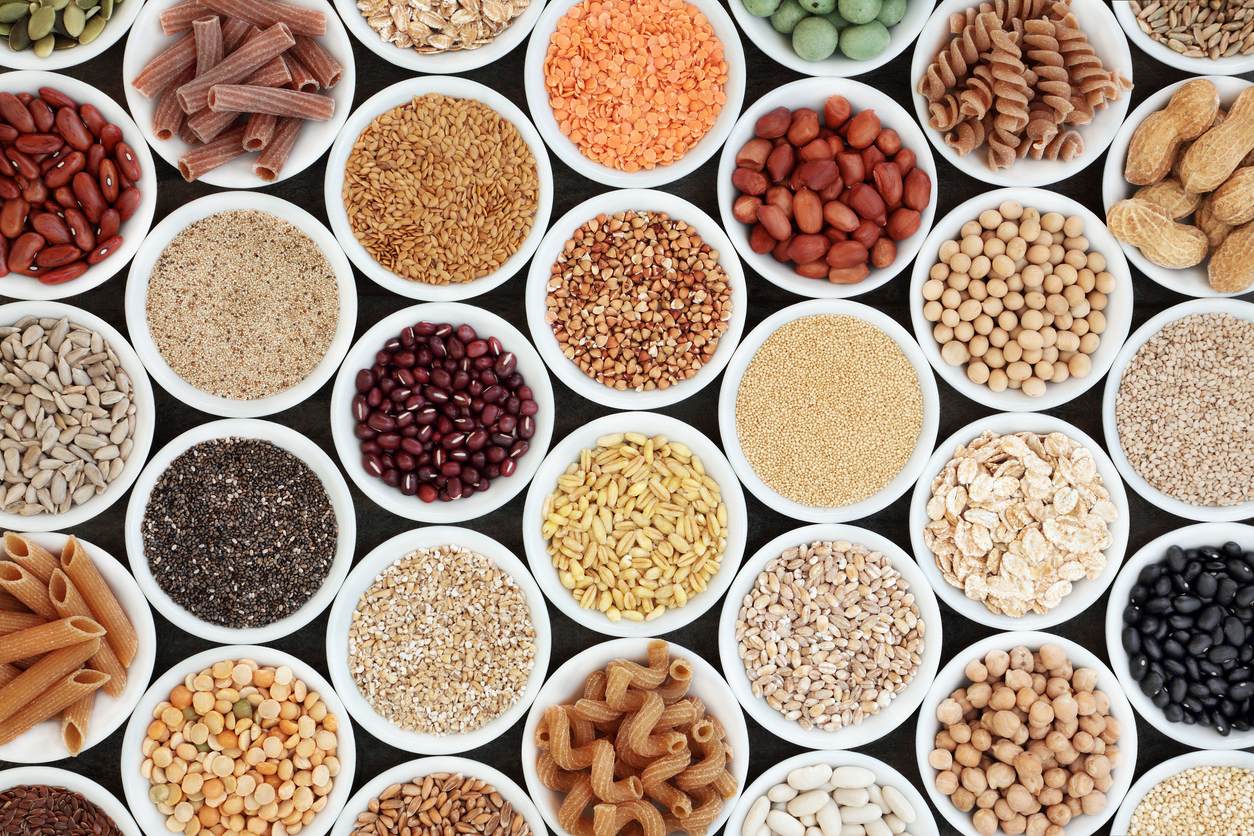While most people think of lithium as a medication for severe mental health problems, research since the 1970s has strongly suggested that low levels of lithium also function as a nutrient. Rat studies found that lithium deficiency significantly affected reproductive success (Pickett 1992). Studies in goats also found significant reproductive problems, lowered immune status, chronic inflammation and decreased survival in adulthood (Anke 1983, Muller 2010).
Human studies comparing populations exposed to different levels of lithium in local drinking water have also found interesting correlations. While research hints at lower aggression and recreational drug use from lithium, reduced suicide rates and inpatient psychiatric admissions with higher lithium exposure is well documented (Eyre-Watt 2020).
On average, in the United States, individuals consume between 0.65 and 3.1 milligrams of elemental lithium per day. As early as 2002, based on the published data, researchers were suggesting that lithium was an essential trace element. To avoid lithium deficiency, a minimum of one milligram of elemental lithium per day was recommended with an admission that higher levels might provide further benefits (Schrauzer 2002).
Lithium in the Human Body
Lithium is typically consumed as a salt, with most lithium salts being readily soluble in water. After dissolution, lithium ions are effectively absorbed from the gastrointestinal tract and primarily eliminated through the kidneys with a half-life around 24 hours. The human body, on average, contains around 7 mg of lithium (Aral 2008).
Due to similarities with other electrolytes, lithium partially substitutes for sodium in epithelial transport in the gastrointestinal tract and kidneys. In addition, lithium crosses cell membranes slowly and takes between 6 and 10 days to equilibrate between serum and intracellular levels (Singer 1973). This delay has been suggested as an explanation for the slow onset of lithium’s effects in bipolar disorder. Once absorbed, lithium is fairly evenly distributed throughout the body, although a few locations, like the thyroid and pituitary, will concentrate the mineral.
Sources of Lithium
Tap Water
In order to meet daily requirements for lithium, reliable sources of the mineral are needed. Water is often a source of lithium, however concentrations can vary dramatically from location to location. In Texas, research has shown different levels in the drinking water have differing effects on the mental health of the local residents. Levels varying from 2.8 to 219 micrograms per liter were found in local water supplies (Bluml 2013). Obviously, depending on your location, your tap water may or may not be a reliable source of the mineral. In addition, individuals often choose bottled water or filtered tap water, which can decrease lithium intake from local water supplies.
Food Sources
Other than drinking water, food can also be a source of the mineral. However, growing practices in combination with local soil levels appear to have a significant influence on lithium content found in food crops. In addition, if soil levels of lithium get too high, it can have growth inhibiting effects on crops and other plants (Shazhad 2016).
In the minimal published data available, levels of lithium in foods are somewhat variable. Studies often found the same foodstuff could have undetectable levels up to a few milligrams per kilogram of lithium. The main sources of lithium in food are generally nuts, legumes, cereal grains and vegetables. Of the vegetables, leafy greens may have higher levels, but again data is too sparse to draw solid conclusions (Szklarska 2019, Gonzalez-Weller 2013, Sobolev 2019). Many of the foods only had measurements from one or two sources, making the data difficult to generalize, especially considering the differences among published reports. In Spain, for example, significantly higher levels were found in meat, poultry and dairy products—different from other locations.
Lithium levels found in common foodstuffs:

While these levels may seem low, they can easily add up to one milligram or more per day. For example, a serving of nuts is generally considered to be 45 grams. In one serving, you would consume around 400 μg of elemental lithium, almost half the minimum recommended per day.
Conclusion
Lithium is likely a micronutrient necessary for maintaining health that needs to be consumed in the human diet on a regular basis. For most individuals, adequate lithium intake is possible from a healthy diet that includes plenty of nuts, seeds, beans, vegetables and whole grains. Tap water may also help meet daily requirements. However, more data is needed to adequately assess general lithium intake, and some form of supplementation may be necessary or helpful in certain populations, especially those at risk for mental health conditions.
Ready to learn more about nutritional and functional medicine for mental illness? Check out our Intro to Functional & Integrative Online Training!
References
Pickett EE, O’Dell BL. Evidence for dietary essentiality of lithium in the rat. Biol Trace Elem Res. 1992;34(3):299-319. doi:10.1007/BF02783685
Anke M, Groppel B, Kronemann H, Gru¨n M: Evidence for the essentiality of lithium in goats. In Anke M, Baumann W, Braunlich H, Bruckner C (eds): “Proceedings 4. Spurenelement Symposium 1983.” Jena: VEB Kongressdruck. 1983:58–65.
Müller R, Anke M, Betz L. Essentiality of the Ultra Trace Element Lithium to the Nutrition of Animals and Man. Scientific symposium of industrial toxicology 2010. 2010:134-143.
Eyre-Watt B, Mahendran E, Suetani S, Firth J, Kisely S, Siskind D. The association between lithium in drinking water and neuropsychiatric outcomes: A systematic review and meta-analysis from across 2678 regions containing 113 million [published online ahead of print, 2020 Oct 13]. Aust N Z J Psychiatry. 2020;4867420963740. doi:10.1177/0004867420963740
Schrauzer GN. Lithium: occurrence, dietary intakes, nutritional essentiality. J Am Coll Nutr. 2002;21(1):14-21. doi:10.1080/07315724.2002.10719188
Aral H, Vecchio-Sadus A. Toxicity of lithium to humans and the environment–a literature review. Ecotoxicol Environ Saf. 2008;70(3):349-356. doi:10.1016/j.ecoenv.2008.02.026
Singer I, Rotenberg D. Mechanisms of lithium action. N Engl J Med. 1973;289(5):254-260. doi:10.1056/NEJM197308022890508
Blüml V, Regier MD, Hlavin G, et al. Lithium in the public water supply and suicide mortality in Texas. J Psychiatr Res. 2013;47(3):407-411. doi:10.1016/j.jpsychires.2012.12.002
Shahzad B, Tanveer M, Hassan W, et al. Lithium toxicity in plants: Reasons, mechanisms and remediation possibilities – A review. Plant Physiol Biochem. 2016;107:104-115. doi:10.1016/j.plaphy.2016.05.034
Szklarska D, Rzymski P. Is Lithium a Micronutrient? From Biological Activity and Epidemiological Observation to Food Fortification. Biol Trace Elem Res. 2019;189(1):18-27. doi:10.1007/s12011-018-1455-2
González-Weller D, Rubio C, Gutiérrez ÁJ, et al. Dietary intake of barium, bismuth, chromium, lithium, and strontium in a Spanish population (Canary Islands, Spain). Food Chem Toxicol. 2013;62:856-858.
Sobolev OI, Gutyz BV, Darmohray LM, et al. Lithium in the Natural Environment and its Migration into the Trophic Chain. Ukranian J Ecology. 2019;9(2):195-203.


